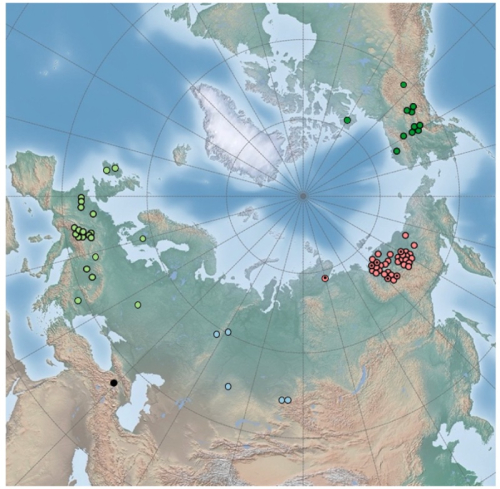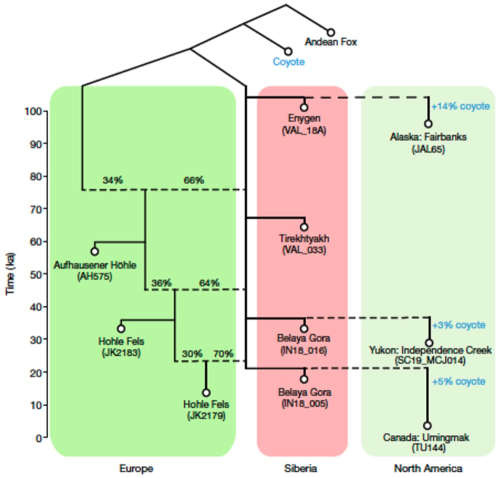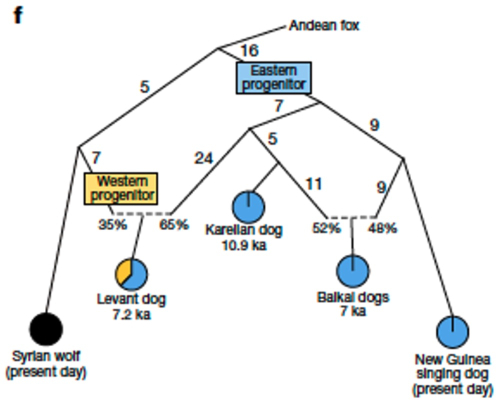An international cadre of scientists* from almost 70 institutions worldwide recently reported their findings in the scientific journal Nature that the domesticated dog (Canis familiaris) arose from two populations of ancestral grey wolves (Canis lupus) (see "Grey wolf genomic history reveals a dual ancestry of dogs").
The grey wolf is recognized as the species that survived the last Ice Age (the last glacial maximum or LGM occurring ~28,000-23,000 years ago) to give rise to domesticated dogs, but little is known about progenitor wolf populations. Siberian grey wolves are known to have survived from this period but it is unknown the extent to which other grey wolf populations, which were widely distributed in the Northern Hemisphere for the last few hundred thousand years, either went extinct or responded to changes in climate by adaptation. Archeological evidence places domesticated dog populations arising ~14,000 years ago, and divergence from grey wolf species occurring ~40,000-14,000 years ago. But analyses of modern grey wolves and dogs have been unable to resolve domesticated dog origins due to, inter alia, dog genetic diversity and local extinction and gene flow occurring after domestication.
To attempt to address these deficiencies, the researchers assessed 72 ancient wolf genomes over the past 100,000 years from Europe, Siberia, and North America:
 Sites of ancient wolf genomes reported in the study
Sites of ancient wolf genomes reported in the study
(consisting of 66 newly sequenced genomes, 5 previously sequenced specimens, and one ancient dhole genome from the Caucasus, dated to be more than 70,000 years old and used as an "outgroup" control). These samples were ~69% males and through mitochondrial DNA analysis averaged 21,573 ± 5,133 years old. As explained in the paper, the researchers "merged single-nucleotide polymorphism (SNP) genotypes called from these genomes with those from worldwide modern wolves (n = 68), modern (n = 369) and ancient (n = 33) dogs, and other canid species [and t]he total dataset spans the last 100,000 years."
The results of genetic analyses on these SNPs showed a directionality of gene flow in wolf populations, from the Siberian wolf populations to the European and Central Asian wolves and not vice versa, starting after a time less than ~23,000 years ago; these conclusions were supported by mitochondrial DNA assessments ("our results suggest that Siberia acted as a source and Europe as a sink for migration throughout the Late Pleistocene and show no evidence of gene flow in the other direction"). Paradoxically, these results also showed that there remains what the researchers termed a "minority fraction of deep European ancestry" that has persisted in modern wolf populations, having 10-40% of their ancestry that is more divergent than the oldest Siberian wolves studied. Some of this diversity was identified as coming from the African grey wolf in the Near East and an unknown canid originating in Tibet. This persistent evidence indicated to these researchers that grey wolves, unlike other megafauna (e.g., woolly mammoths) did not come close to extinction. And some North American grey wolf populations show evidence of admixture with coyotes, species that began to diverge from one another ~700,000 years ago (no similar coyote-wolf admixture was seen in Eurasian grey wolf populations). The genetic relationships between these populations were represented in the paper by this graph:

And while there is some evidence of Siberian grey wolf genetic admixture in North American wolf populations the genetic evidence reported by these authors showed no reverse admixture of North American grey wolf populations into Siberian grey wolves. The evidence also suggests local extinction in North American grey wolf populations during the LGM of the last Ice Age.
In comparing the proportion of genetic variation between rather than within grey wolf populations, the researchers found that wolf populations showed low levels of variation even between populations in distant regions in the Pleistocene. In the last ~10,000 years, however, (i.e., the Holocene) further gene flow from Siberia was not detected while gene flow from European populations was seen in modern wolves from China and Siberia, with population bottlenecks perhaps (the authors speculate) being due to human "persecution" in the past few centuries (supported by widespread effective population size declines).
In further analyzing the observed connectivity in grey wolf populations throughout the past 100,000 years the authors report assessment of alleles at specific genetic loci, finding twenty-four regions in grey wolf genomes having some evidence for natural selection. The observed connectivity between grey wolf populations resulted in mutations becoming fixed in these population between 40,000 and 30,000 years ago in the case of the IFT88 gene (a gene wherein disruption results in craniofacial abnormalities and cleft lips in mice and humans) on wolf chromosome 25, a characteristic shared with domesticated dogs. (It might be recalled that changes in visage in domesticated dogs has been hypothesized as being relevant to their acceptance by humans; see "Selection for Facial Features in Domestic Dogs: The Evolution of Cuteness"). Additionally, these researchers reported that "[t]hree regions with evidence for selection overlap olfactory receptor genes, with variants on chromosome 15 increasing in frequency from close to 0% to 100%" between 45,000 and 25,000 years ago, "suggesting that olfaction was a recurrent target of adaptation in wolves" and that "[m]ost of the detected selection episodes occurred before the divergence of dogs, and dogs share the selected alleles." Illustrating how natural selection and intentional breeding can operate on similar phenotypic determinants, the authors report that "a region on chromosome 10, where variation among dogs is associated with body size, drop ears and other traits [has been] under recent selection in specific dog breeds" was also found to have been selected in wolves in the last 20,000 years.
While the impetus for the reported research was to better understand the origin of domesticated dog species from earlier wolf populations, the results of these studies showed that history is more complex than anticipated. A closer relationship was observed between modern domesticated dogs from eastern Eurasian wolves than western Eurasian populations, but modern domesticated dogs in the Near East and Africa could trace their ancestral species from a population of grey wolves related to extant southwestern Eurasian populations. Recent population genetic events, including admixture and population changes further complicate the picture, according to the paper. As summarized, the authors state that "[t]hese results could be taken to support an eastern or central Eurasian dog origin outside of north-eastern Siberia, but we cannot draw firm geographical conclusions in the absence of ancient wolf genomes from these and other candidate regions."
To further complicate matters, their results showed that "dogs have variable proportions of two distinct components of wolf ancestry" between Siberian wolf progenitors and European grey wolf populations, as illustrated by this diagram:
 The authors state that the data were not sufficiently robust to distinguish between there having been an independent domestication event from these population or from admixture of domesticated dogs with local wolf populations. As a consequence, the researchers failed to find a direct match between either of these ancestral species and these two sources of modern domesticated dogs, concluding that "the exact progenitor populations remain to be located."
The authors state that the data were not sufficiently robust to distinguish between there having been an independent domestication event from these population or from admixture of domesticated dogs with local wolf populations. As a consequence, the researchers failed to find a direct match between either of these ancestral species and these two sources of modern domesticated dogs, concluding that "the exact progenitor populations remain to be located."
*Anders Bergström, David W. G. Stanton, Ulrike H. Taron, Laurent Frantz, Mikkel-Holger S. Sinding, Erik Ersmark, Saskia Pfrengle, Molly Cassatt-Johnstone, Ophélie Lebrasseur, Linus Girdland-Flink, Daniel M. Fernandes, Morgane Ollivier, Leo Speidel, Shyam Gopalakrishnan, Michael V. Westbury, Jazmin Ramos-Madrigal, Tatiana R. Feuerborn, Ella Reiter, Joscha Gretzinger, Susanne C. Münzel, Pooja Swali, Nicholas J. Conard, Christian Carøe, James Haile, Anna Linderholm, Semyon Androsov, Ian Barnes, Chris Baumann, Norbert Benecke29, Hervé Bocherens, Selina Brace, Ruth F. Carden, Dorothée G. Drucker, Sergey Fedorov, Mihály Gasparik, Mietje Germonpré, Semyon Grigoriev, Pam Groves, Stefan T. Hertwig, Varvara V. Ivanova, Luc Janssens, Richard P. Jennings, Aleksei K. Kasparov, Irina V. Kirillova, Islam Kurmaniyazov, Yaroslav V. Kuzmin, Pavel A. Kosintsev, Martina Lázničková-Galetová, Charlotte Leduc, Pavel Nikolskiy, Marc Nussbaumer, Cóilín O'Drisceoil, Ludovic Orlando, Alan Outram, Elena Y. Pavlova, Angela R. Perri, Małgorzata Pilot, Vladimir V. Pitulko, Valerii V. Plotnikov, Albert V. Protopopov, André Rehazek, Mikhail Sablin, Andaine Seguin-Orlando, Jan Storå, Christian Verjux, Victor F. Zaibert, Grant Zazula, Philippe Crombé62, Anders J. Hansen, Eske Willerslev, Jennifer A. Leonard64, Anders Götherström, Ron Pinhasi, Verena J. Schuenemann, Michael Hofreiter, M. Thomas P. Gilbert, Beth Shapiro, Greger Larson, Johannes Krause, Love Dalén & Pontus Skoglund.